Sukiyabashi Jiro
Feb 05, 2013 in sushi, travel, restaurant, japanese, review, japan. Read the original on: Tiny Urban Kitchen

This is the eleventh and final post in the series titled Tasting Tour of Tokyo detailing my recent trip to Japan. Other posts include Kikunoi Akasaka, Rokurinsha, Mikawa Zezankyo, Kaoriya, Sushi Sawada, Sushi Aoki, Street Food in Tokyo, Omotesando Koffee, Ukai-tei, and Japan's Underground "Depachika" Markets
Dreaming of Sushi
How often does one get to personally taste the handiwork of a man who has been obsessively honing his craft for over seventy-five years?
Meet Jiro Ono, one of the most famous sushi masters in the world. The Japanese government considers him a "national treasure." The Michelin Guide has awarded him its highest honor, three Michelin stars. Many world famous chefs, such as Eric Ripert and Joel Robuchon, consider him one of the best sushi chefs in the world. Anyone who has seen the movie Jiro Dreams of Sushi understands the devotion, dedication, and near-obsession this eighty-six year old man has for the art of creating perfect sushi.
His perfectionism is evident in the way he runs his restaurant. Apprentices begin by learning how to wring out hot towels for guests. For months, all they do is wash dishes and clean, only saying "yes, yes" and never talking back. Eventually, they are "promoted" to other tasks, such as making rice and massaging octopus (for up to 45 minutes to make it soft!). Somewhere in the middle of all this, they finally get the chance to touch fish, make tamago, and eventually - the holy grail - work the front counter with Jiro.

Jiro's restaurant, Sukiyabashi Jiro, has been called one of the most difficult reservations to get in the world. This tiny sushi bar is hidden in the basement of a subway station and only has ten seats. Rumor has it that they only speak Japanese and thus won't even talk to foreigners who try to reserve in English. You may need to book up to a year in advance. Forget modern conveniences like email or credit cards at this old establishment.
I'd heard about this place years ago when I started researching restaurants to try in Tokyo. However, it wasn't until recently that I more deeply appreciated the back story of this little place.
"Jen, you have to watch Jiro Dreams of Sushi. I think you'll love it."
My friends had purchased the Blu-ray disc after seeing the movie because they loved it so much. Soon after we watched it, Bryan declared that he wanted to go to Jiro. Unfortunately, it was just about a month before our Tokyo trip. The likelihood of booking anything so late into the game looked extremely grim. Nevertheless, Bryan's pretty relentless when he really wants something, and will pursue as hard as he can until he gets what he wants.
First Attempt
"Ring . . . . Ring . . ."
"Moshi moshi?"
[in my broken Japanese] "May I make a reservation for dinner?"
[still in Japanese - this is a paraphrase since I'm really not sure I understood everything he said]
"We are sorry. We cannot take the reservation. Please call your hotel concierge and have them make the reservation for you."
I turned to Bryan.
"I'm really sorry, but I tried. They said we need to have the hotel concierge call."
Minor problem: we didn't have a hotel booked yet, which meant there was no concierge.
Second Attempt
Did I mentioned Bryan was motivated? Within a day Bryan informed me, "OK, I've booked a hotel for the trip. Can you email the concierge?"
Soon after, yet another disheartening email:
"Sukiyabashi Jiro is very specific traditional sushi restaurant, having very strict reservation policy. They only take reservation for foreigner who has Japanese friend or who live in Japan. Do you have any Japanese friends or colleague who live in Japan?"
Defeated, yet again.
Third Attempt
Relentless, Bryan contacted his Japanese colleague in Tokyo. The Japanese colleague asked his assistant to call Sukiyabashi Jiro to make the reservation. The restaurant sent an email which included the price of a meal, the cancellation policy, along with other slightly unusual requests, such as "please refrain from wearing a lot of perfume." To confirm the reservation, the assistant hand delivered 20,000 yen cash to Jiro, which Bryan's colleague graciously lent us.
Wow. Crazy.
We couldn't believe it, but we finally had a real, solid - ahem financially backed - reservation to the most sought after sushi restaurant in the world.
Finding Jiro

I know I keep saying this, but it's absolutely true. Restaurants are really hard to find in Tokyo. Even though we are holding really detailed instructions from Bryan's Japanese colleague's assistant (who is truly sweet in trying her hardest to take care of us), we still get lost.
Pictured above is the corridor at the Ginza Subway Station into which you need to turn (C6).
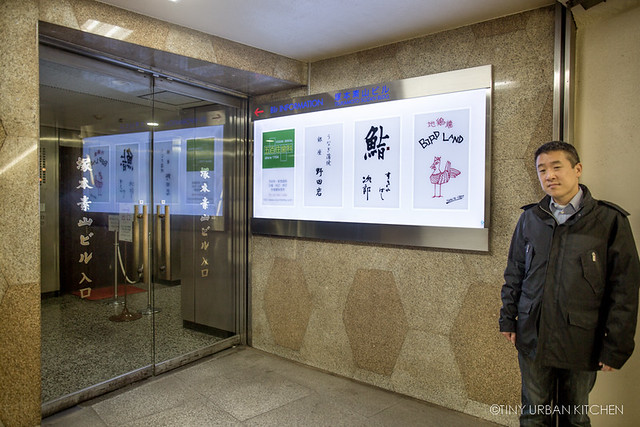
We blindly walk past these glass doors the first few times, heading instead straight up the steps out into the street.
Finally, after asking a store clerk (who chuckles and says, "actually, Jiro is right underneath this store"), we head back down the stairs and notice (for the first time) a set of bright gleaming doors.
If you don't read kanji, it's easy to miss the sign that says "Sukiyabashi Jiro." One easy way is to note that Jiro is right next to Birdland (a very well known yakitori place), whose sign is written in English.

Once you enter the doors, you'll see Birdland on your left and the humble sliding doors of Jiro straight ahead. It is surreal seeing the restaurant for real after seeing it so many times in the movie.
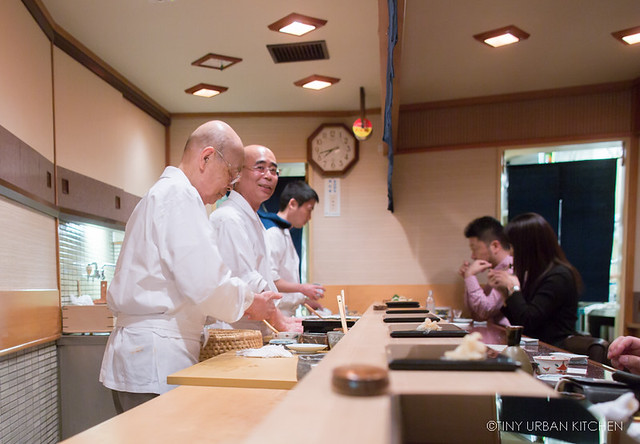
As we enter, we see both Jiro and his elder son, Yoshikazu, who is also a key character in the movie. It is so weirdly familiar, even though we've never stepped foot into this place.
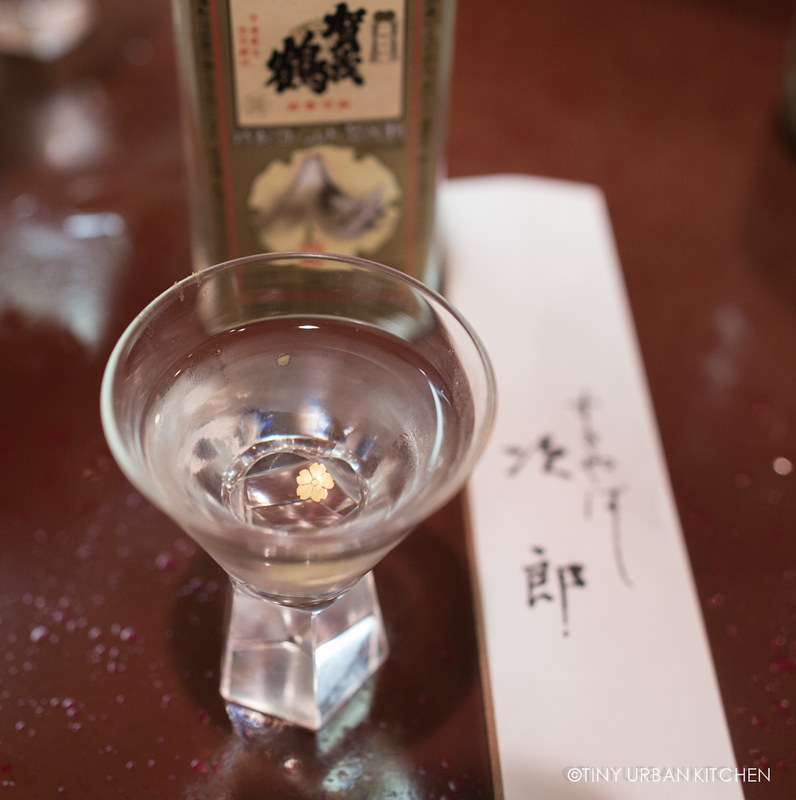
Bryan starts with cold beer, and then we also order a bottle of sake to go with the meal. I am tickled by the cute little gold flower that lazily drifts to the bottom of my cup.

We sit right at the end of the bar. This is good and bad, I guess. Bad because we are sort of far away from Jiro, which means we can't really see his magical sushi-making skills up close. Good, because we feel a bit removed from his serious probing stare, which often makes diners nervous because they feel pressured to eat quickly. Sitting a bit "away" from the rest of the diners gives me a chance to relax, take my photos, and  enjoy my bites at my own pace.
The Sushi
Jiro's restaurant only serves sushi. No sashimi, no appetizers, no side dishes. They ask you your drink order, present you with the list of sushi being served that day, and then ask if you have any allergies. The menu is translated into English, which makes things a lot easier.
It's been widely reported that a meal at Jiro flies by, with sushi being thrown at you almost a piece per minute. Diners lament about feeling "rushed", pressured to finish a meal in 20 minutes under the watchful eye of Jiro. One article sums it up quite bluntly, calculating that a meal at Jiro will cost you about $20/minute. Our experience is not quite so rushed; however for fun, I wrote down the times so you could get a sense of the pace of our meal.
I will confess that photographing probably slowed me down a tad, though I pretty much kept up the pace. There was one point where Bryan started beating me and Jiro began giving pieces to Bryan only (!!!). I quickly fixed that, and I believe at the end we both received equal amounts of sushi.
 7:01
7:01karei (sole fish)
We start with a gorgeous piece of karei. Immediately, the fantastic rice texture jumps out at me. This is among the best sushi rice I've ever had. Eric Ripert has called Jiro's rice "a cloud that just explodes in your mouth". Jiro sources his rice from a very particular rice purveyor, a person who saves his best rice for Jiro and refuses to sell to anyone who cannot give the rice its proper glory (including the Grand Hyatt in Tokyo!).
Jiro's rice is slightly warm (like body temperature) and soft, yet you can still taste each individual grain. I haven't had such good rice since my meal at Mizutani, whose chef is one of Jiro's proteges.
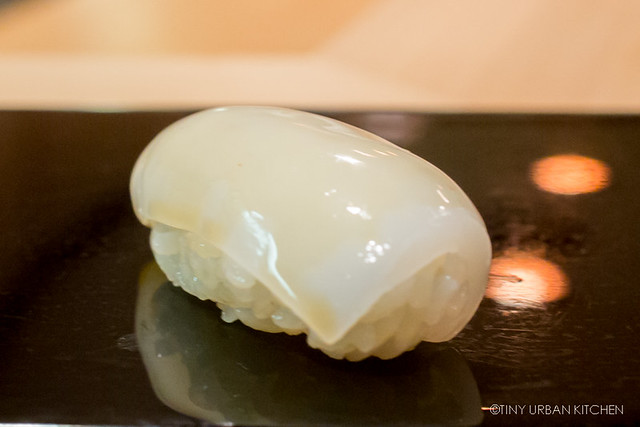 7:03 Sumi-ika (Squid)
7:03 Sumi-ika (Squid)In the movie, we learn that Jiro's apprentices massage octopus for 45-50 minutes in the morning before cooking it. Jiro has learned that octopus needs to be massaged this long, not the 30 minutes he was taught. I regret that the octopus does not appear on our menu. However, the sumi-ika (squid) is one of the best I've ever had. It is insanely soft (not a tad bit of rubbery-ness), yet has a distinct "bite" to it. It's hard to explain, but it goes perfectly with the special rice. It makes me seriously wonder whether he massages his squid too.
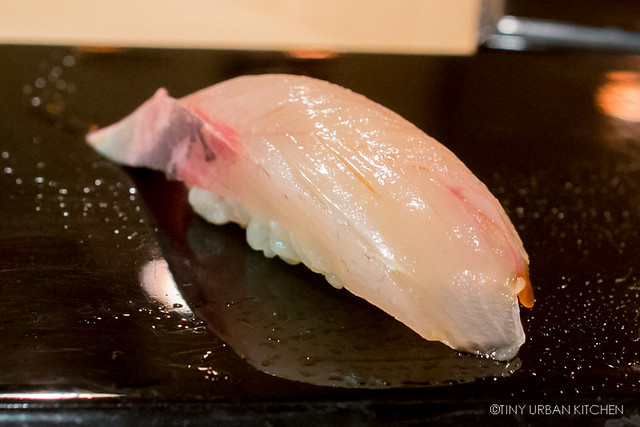 7:05 Inada (Yellowtail)
7:05 Inada (Yellowtail)At Sukiyabashi Jiro, as it is with many other high-end sushi restaurants, you don't dip the sushi into any soy sauce or wasabi. Jiro tailors the flavor exactly as it should taste, and you just eat it. For many pieces, including the one pictured above, Jiro brushes just the right amount of soy sauce on top. The wasabi is already inside, so the bite is already perfect as is.
Bryan quickly notices that Jiro's wasabi is a lot stronger than ones he's tasted at other sushi establishments in Japan. Up to this point, I had pretty much conceded that freshly made wasabi in Japan is sweeter and more flavorful, but definitely packs less of a punch. Jiro shows us otherwise.
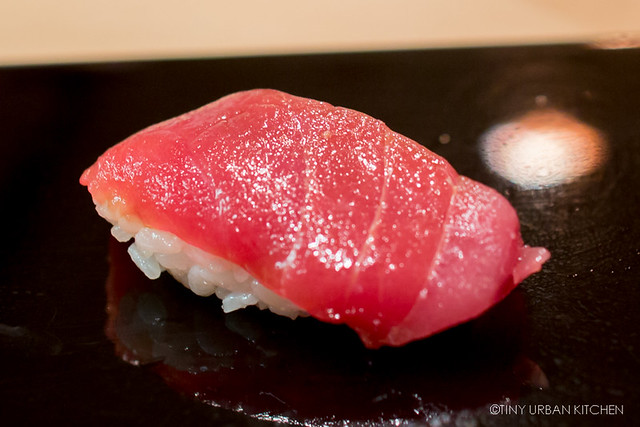 7:06 Akami (tuna)
7:06 Akami (tuna)We move onto a mini-tasting of tuna, beginning with a simple akami (red tuna)Â and ending with a couple pieces of chutoro (tuna belly).
Tuna in Japan is completely different from most tuna in America. Before I tried tuna in Japan, I used to dislike tuna sushi because I thought it was bland and flavorless. There is nothing further from the truth. Tuna in Japan has beautifully complex flavors. In fact, it is probably one of my favorite sushi fish in Japan.
 7:08Â Chutoro (semi-fatty tuna)
7:08Â Chutoro (semi-fatty tuna)Jiro sources his tuna from one very particular tuna dealer at Tsukiji Fish Market who possesses similar levels of obsession about tuna quality. Jiro ages his tuna for ten days, which results in a much more flavorful piece of tuna. The resultant fish stands up well to the strongly vinegared rice, another very signature (and polarizing) aspect of Jiro's sushi.
A lot of Japanese cuisine is defined by subtle flavors. Jiro's sushi definitely pushes the bolder edge of the envelope with its stronger flavors. The rice is more strongly vinegared and the wasabi has a bigger punch. Not everyone prefers his strongly vinegared rice, but it definitely holds up well to many of the stronger flavored sushi pieces. Bryan has always loved strong flavors, and thus prefers Jiro's sushi to most others he's ever had.
 7:09Â Chutoro (semi-fatty tuna)
7:09 Chutoro (semi-fatty tuna)I can't get over the intricate "veins" of fat distributed throughout this piece of fish. Jiro has truly procured some of the best tuna belly from the fish market. I find it interesting that there is no otoro (the fattiest tuna belly) on the menu. I can only conclude that there wasn't a piece that was good enough for Jiro's standards that morning.
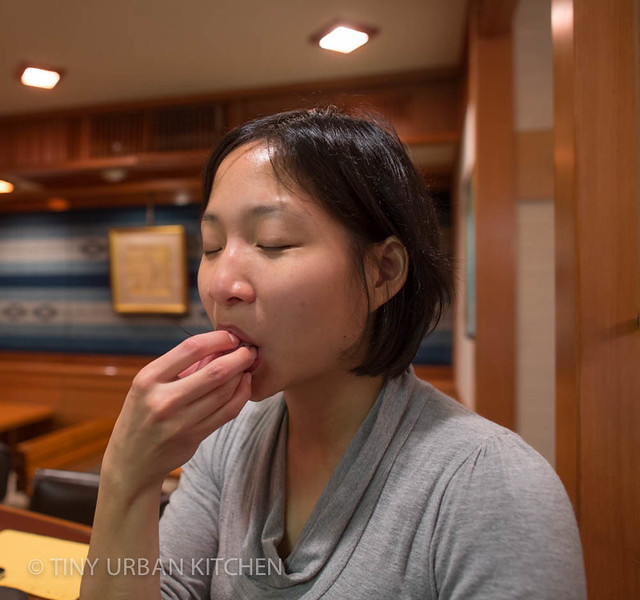
It's quite alright, actually. I am quite content enjoying my pieces of akami and chutoro.
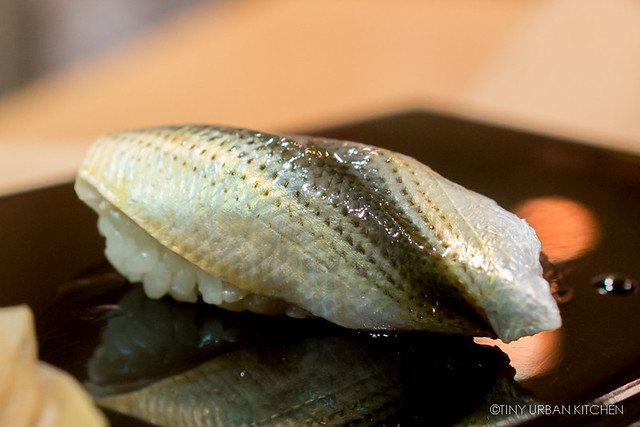 7:11 kohada (gizzard shad)
7:11 kohada (gizzard shad)Jiro makes sushi in the Edomae tradition. Edomae (often just called "Edo" style sushi) refers to a style of sushi that emerged in the late 1800's in Japan. Edomae literally means "in front of Edo", and the style uses only fish and seafood available during the Edo period when Tokyo was a shogun capital.
 7:14 Mushi-awabi (abalone)
7:14 Mushi-awabi (abalone)Those that stay true to the style only use seafood from Tokyo Bay. Typically, they cure or marinate the fish, using techniques that were common back in the Edo days prior to the invention of refrigeration. This means that some pieces may taste saltier or more preserved. Even Jiro's strongly vinegared rice is sort of a nod to the Edomae tradition.
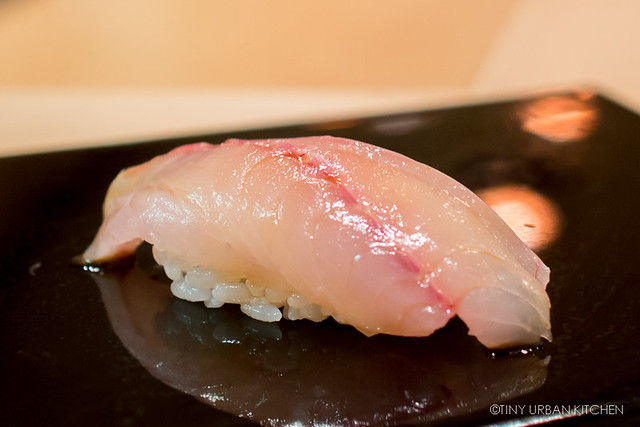 Â 7:15 Aji (Jack Mackerel)
 7:15 Aji (Jack Mackerel)Aji, another one of my favorite fish, is fabulous. I am loving the perfection of his rice along with the insanely high quality of the fish. Yes, I've only been here for 15 minutes, but it already feels like I've been here for quite some time.
 7:17 Hamaguri (Clam shell)
7:17 Hamaguri (Clam shell)Typically I'm less of a shellfish type of person and prefer raw fish sushi over most types of shellfish. For some reason I don't notice this while I'm at Jiro, even though over half the menu is not fish. He's somehow crafted the tasting menu in a way that keeps me interested.
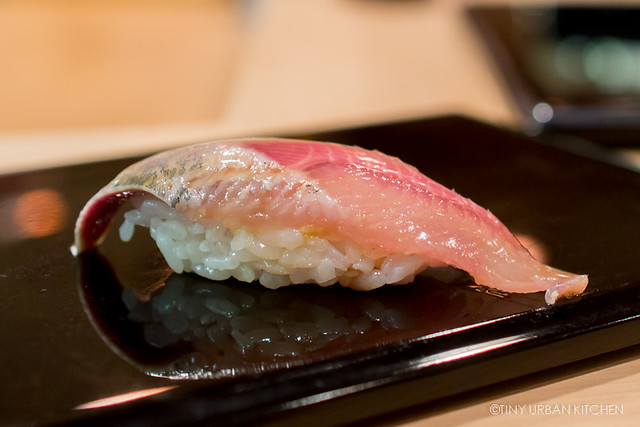 Â 7:19 Iwashi (Sardine)
 7:19 Iwashi (Sardine)One way in which he does this is to intersperse pieces of fish between every few pieces of shellfish.
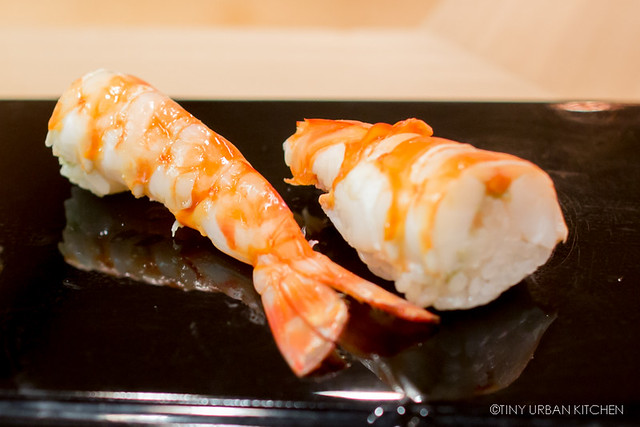 7:21 Kurumaebi (Prawn)
7:21 Kurumaebi (Prawn)The fresh prawn is served in two pieces. Though it is juicy and sweet, I actually think that it's still not as good as the "super fresh" one I've had Kyubey, which, admittedly, was killed in front of my eyes just minutes before I ate it.
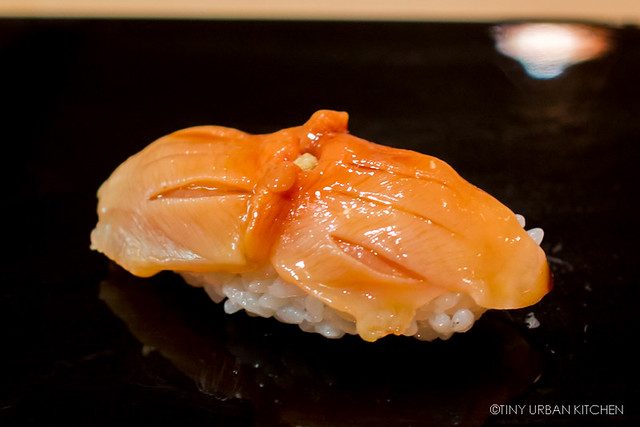 7:26 Akagi (Ark Shell)
7:26 Akagi (Ark Shell)Though most pieces have been coming out every 1-2 minutes, there is a five minute gap between the previous piece and this next piece of akagai (ark shell). It turns out Jiro has left the sushi bar temporarily in order to take a photo with a guest who is leaving. We take a mental note to remember to ask him for a photo at the end.
We do love the akagai, which has a unique, almost crunchy, texture that sort of "pops" as you bite into it. It is surprisingly good, and becomes one of our favorite shellfish pieces.
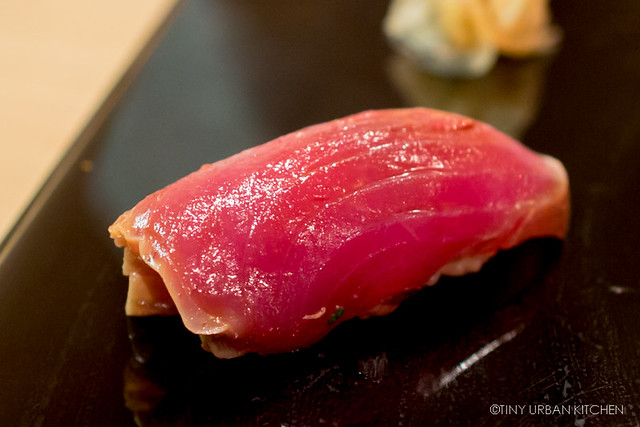 Â 7:28 Katsuo (Bonito)
 7:28 Katsuo (Bonito)Katsuo, or skipjack tuna, has always been one of my favorites. Here's it is just slightly cured (or salted?) and tastes phenomenal.
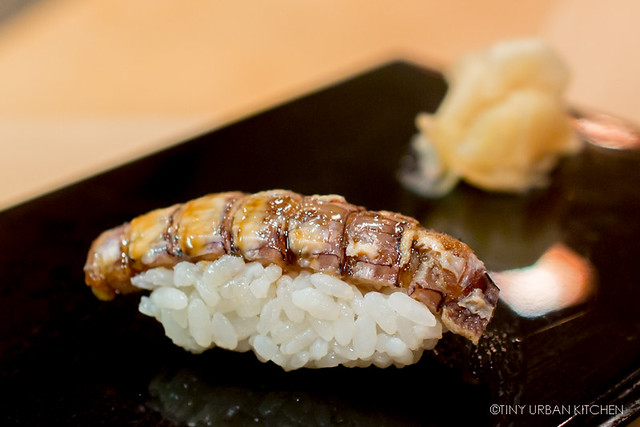 Â 7:31 Shako (Squilla)
 7:31 Shako (Squilla)The shako is probably the only one I don't really like. The texture is unlike any sushi I've ever had. It sort of reminds me of dried shrimp - mealy and a bit crumbly. Bryan enjoys it, saying that the deep umami flavors remind him of unagi (freshwater eel). I can sort of see where he gets that, although the texture is so different from unagi that I can't seem to quite agree 100%.
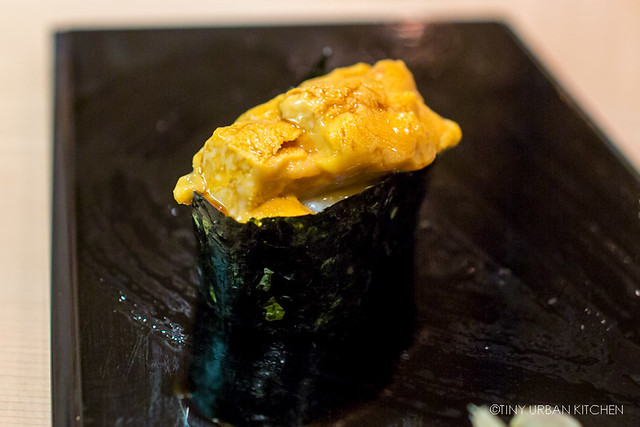 7:32 - Uni (Sea Urchin)
7:32 - Uni (Sea Urchin)The uni is fantastic, just like most of the uni I've tried in Japan. It's sweet, creamy, and has absolutely no hint of the funky "stinkiness" that I associate with most of the uni I've tried in the US.
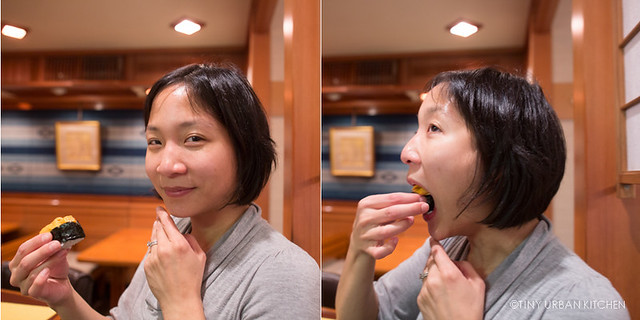
I'm hesitant that it will fit in my mouth in one bite, but Bryan insists it's the only way to truly enjoy it. He's right. I love how the uni just dissolves and incorporates itself all around the perfect rice. Quite a heavenly bite, I must say.
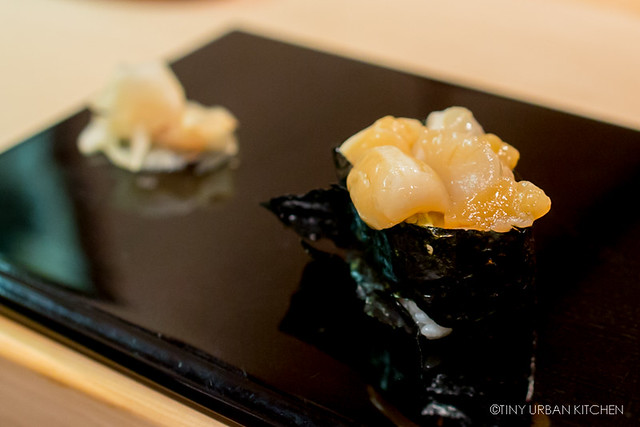 7:37 - Kobashira (Baby Scallops)
7:37 - Kobashira (Baby Scallops)Kobashira (baby scallops) are piled on top of a gunkan (warship) roll, a style first invented at Kyubey. These scallops are super sweet and also very oishii (delicious).
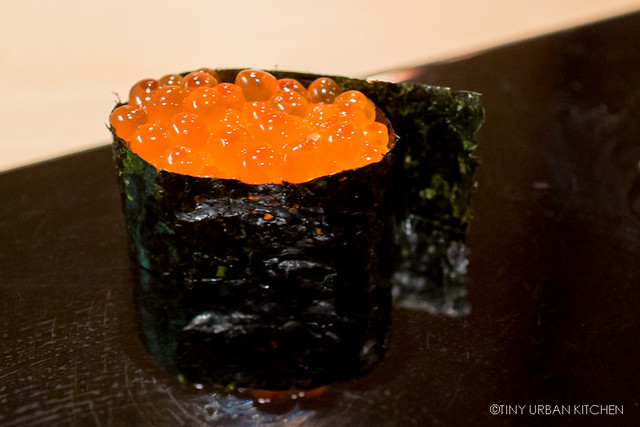 Â 7:40 Ikura (Salmon roe)
 7:40 Ikura (Salmon roe)Ikura (salmon roe) is bursting with its fragrant, flavorful, briny juices. Again, underlying all of these pieces, it's the perfect temperature of every component plus the texture of the special rice that creates each ethereal mouthwatering bite.
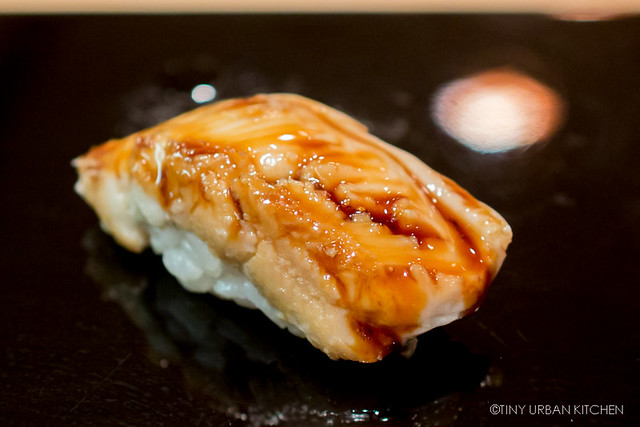 Â 7:42 Anago (Sea Eel)
 7:42 Anago (Sea Eel)The anago is melt-in-your-mouth soft. This is the type of bite that makes me close my eyes and just revel in its perfection. I love the slightly sweet sauce that's brushed on top.
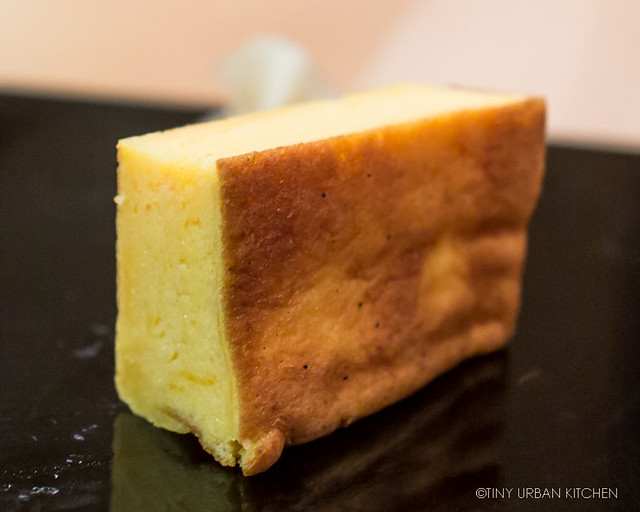 Â 7:46
 7:46And then - the signal that things are about to end - the perfect tamago.
Getting the tamago (egg omelet) right appears to be a near-impossible goal for young apprentices at Sukiyabashi Jiro. In the movie, one of the senior apprentices, Daisuke Nakazawa, describes how he made over 200 tamago -Â all rejected by Jiro - before finally achieving spongy, custard-like perfection. When Jiro finally indicated his approval, Nakazawa wept like a baby.
The tamago here is awesome. Blended somehow with fish paste and sugar (among other ingredients), the tamago is sweet yet definitely has underlying tones of subtle umami. The razor-thin edge is gorgeously browned, and the entire piece is luxuriously spongy, moist, and soft. It almost tastes more like a delicate sponge cake than a traditional omelet.
We slowly take small bites out of it, savoring each small piece.
It has been exactly 45 minutes since we tasted our first bite.
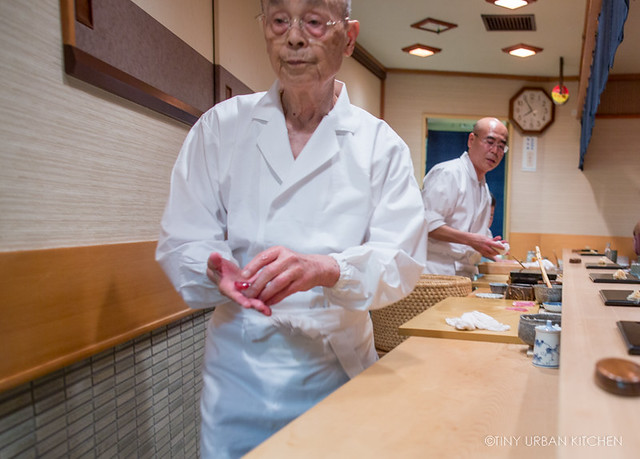
At the end of the meal, Jiro comes and asks whether we want any extra pieces. I am seriously stuffed at this point, and I tell Bryan I can't do it.
Bryan's rationale?
We may never, ever get the chance to try this man's sushi again. If there are ones we want to try again, we should do it.
Bryan orders three extra: akami, chutoro, and tamago. That's right - the egg omelet was that good.
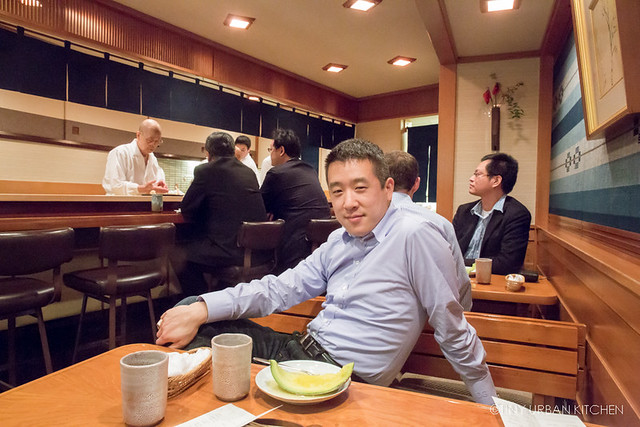
When we finally finish all the sushi, we are whisked off to a side table for "dessert".
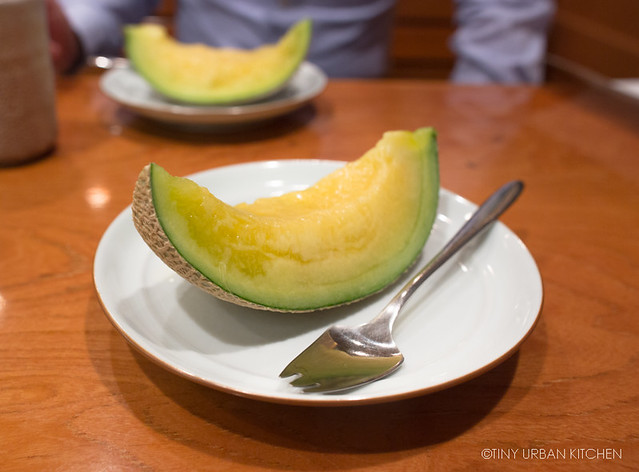
8:04Â Â melon
One of the apprentices hands us each a simple slice of melon accompanied by hot tea. The melon is ripe, super juicy and sweet. It's actually a refreshing end to a clean meal, and I feel energized.
We take our time here. There's less pressure to eat quickly since we are at the end of the meal.

8:30Â
At this point, Jiro seems much more relaxed as well. The restaurant has virtually cleared out at this point, and he seems to be chatting up a storm with one of his Japanese customers - perhaps a regular?
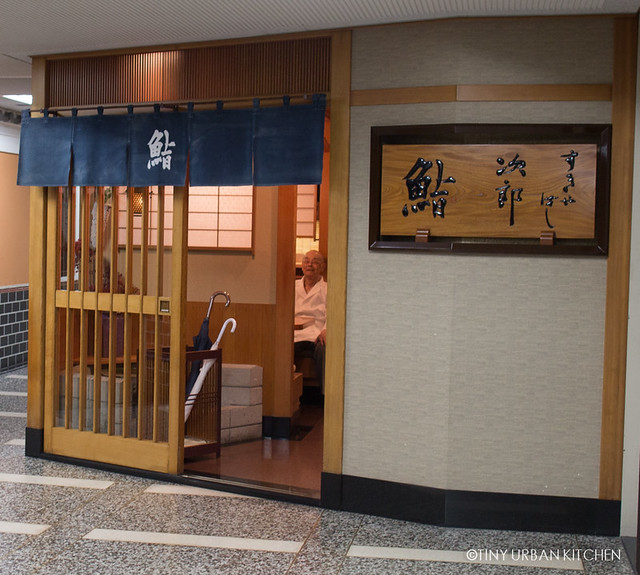 I'm surprised that there are no more customers. Soon afterwards, Jiro retires from the sushi bar and sits down near the front, taking a nice, deserved break after a marathon of sushi making (which probably started early in the wee hours of the morning).
I'm surprised that there are no more customers. Soon afterwards, Jiro retires from the sushi bar and sits down near the front, taking a nice, deserved break after a marathon of sushi making (which probably started early in the wee hours of the morning).As we pay our bill, the apprentice asks us if we want a photo with Jiro.
"Yes, of course, please."
Jiro dutifully stops what he's doing and walks out with us. We don't really know what to say. All my dumbfounded brain can think of at the moment is, "oishii desu, oishii . ."Â (that was really delicious). I feel stupid that I can't express more than that, considering the life-altering meal we've just experienced.
We take a few photos, and then Jiro walks back into the restaurant as the assistant escorts us outside.
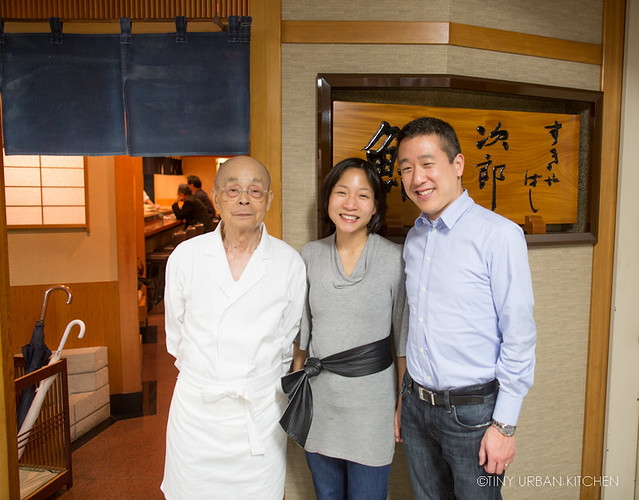
Epilogue
It's interesting to me to see that the restaurant actually was not completely full the night we dined there. Some think that, because Jiro hands out sushi at a rate of a piece a minute, he can really rake in the dough in a night. Just imagine - $400 USD per person, every 20 minutes. You could make a killing each night.
But Jiro doesn't seem to do that. He seems to be quite selective about his customers. My guess is that he tries to leave open some seats for loyal regulars or (perhaps?) even walk-ins? I'm not sure. I was just really surprised that the place wasn't packed. It's nice to think he isn't in it just for the money but instead wants to offer the best, most personalized experience for his diners. That just may mean making only a certain number of pieces of sushi a night.
The night we went, virtually every diner was a foreigner. Most of the diners were snapping photos of the sushi, and I most definitely heard several languages being spoken around the table. It was clear that the fame from the movie had driven even more tourists to seek out his sushi. In some ways, it was weird being one of those tourists in the dining room that night.
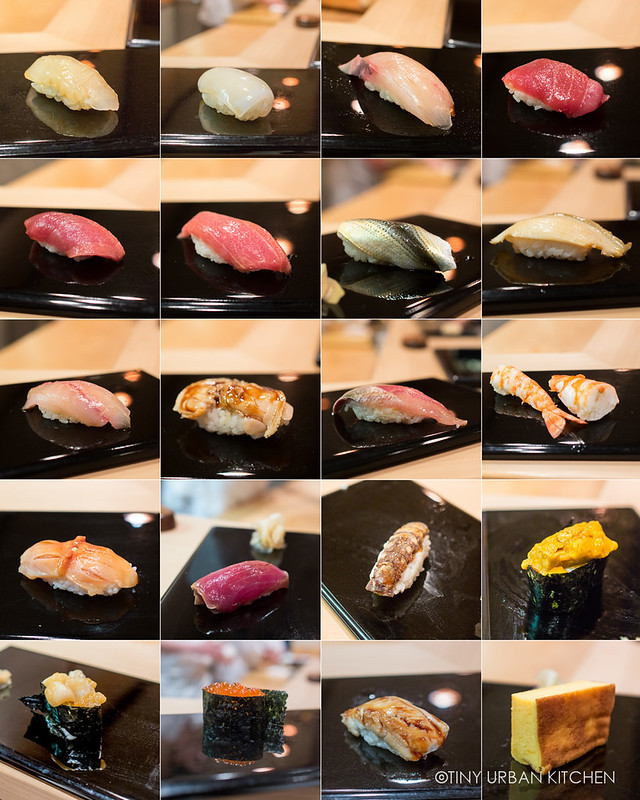
Does it live up to its hype?
I think so. Jiro's sushi is incredible and definitely ranks up there as one of the best sushi meals I've ever had. Several things really stand out: the top notch quality of the fish; the incredible sushi rice; and that delicious tamago.
In my mind, Jiro and Mizutani have provided the two best sushi experiences I've ever had in my life. My dinner at Sushi Mizutani felt a bit more personal partly because I was there with mostly local Japanese people (it was right after the earthquake when foreigners were avoiding Japan) and because I had extended heartfelt conversation with Mizutani (though to be fair, he was pretty shy in the beginning of the meal too).
The atmosphere at Jiro felt a bit more serious. There was definitely an air of reverence by all for the grand sushi master. I didn't exchange a single word with Jiro aside from my half-hearted "oishii" at the end of the meal. All the apprentices were courteous and respectful, but they were also quiet and possibly a bit nervous under the great Jiro?
Jiro believes the key to success is to devote one's life to mastering a skill. Interestingly, despite his accolades, he still says, “even at my age in my work …. I haven’t reached perfection.†Jiro continues to strive to improve this craft he started learning at the age of nine.
"I will continue to climb, trying to reach the top, but no one knows where the top is."
It's hard to imagine that sushi can get better than this, but I'm certainly happy to come back again (if I ever get the opportunity), to find out.
Additional Facts
The restaurant is located right inside Ginza subway station at C6. Look for the Birdland sign. The two restaurants are right next to each other.
Sukiyabashi Jiro
Tsukamoto Sogyo Building Basement 1st Floor 2-15, Ginza 4-chome Chuo-ku, Tokyo, Japan
Phone: 03-3535-3600 (+81-3-3535-3600 from abroad)
Reservations: According to their website, you can either call their international phone number or arrange for a reservation through your hotel concierge. However, as you know from my post above, those two avenues don't always work. From what I can tell, foreigners need to have a local Japanese person hand-deliver a 20,000 yen deposit before the reservation is confirmed.
Cancellation Policy: Cancellations can be made up to 1 day before your reservation. If you cancel the same-day, you will be charged 15,000 yen per person.
Cost: There is only one menu (Chef's Tasting), and it costs ~30,000 yen per person. Payment is CASH ONLY. Our meal came out to a total cost of 74,550 yen (71,000 + 3550 tax). We did order a beer, a bottle of sake, and three additional pieces.
©2009-2012 Tiny Urban Kitchen
All Rights Reserved
Read the original on: Tiny Urban Kitchen
Tiny Urban Kitchen, Jennifer Che
Tiny Urban Kitchen is based out Jen's kitchen in Cambridge and features Boston eats, Jen's cooking experiments (she was a chemist, after all), and food from all her travels.




